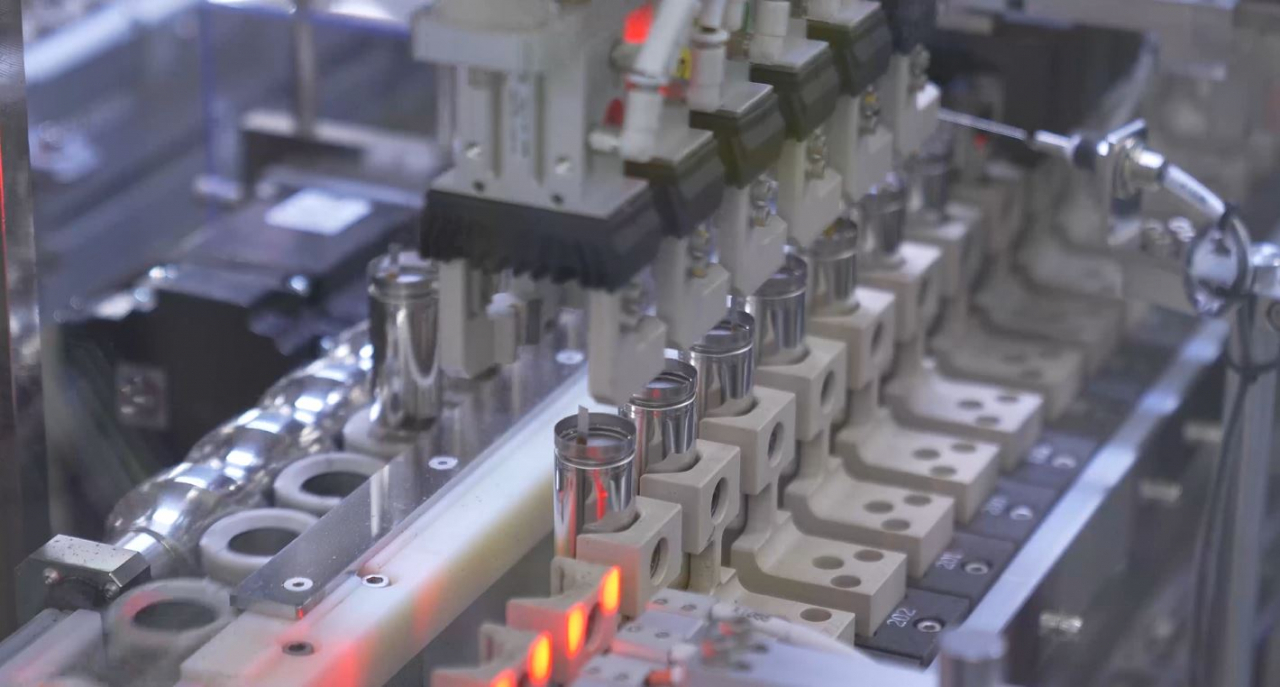Market Now
[KH Explains] Will LG Energy Solution be Tesla's 4680 battery crisis savior?
 |
LG Energy Solution's cylindrical battery cell production line at its Ochang plant in Korea. (LG Energy Solution) |
Four years after Tesla revealed the hyped Cybertruck, its production still lags with 1.9 million orders pending. The bottleneck stems from challenges in mass-producing what are known as 4680 battery cells, which are key to the Cybertruck’s success due to their superior energy density and cost efficiency.
Currently, Tesla can only produce a fraction -- only a tenth -- of the required output, pushing it to lean on global battery manufacturers. LG Energy Solution, a leading South Korean battery manufacturer and a key supplier to Tesla, seems to be in a prime position to capitalize on this demand. However, the technical complexity and innovation required for mass production of these cells means it is still uncertain which manufacturer will lead in this area.
What are 4680 battery cells, and why are they important?
The 4680 battery's name comes from its dimensions: 46 millimeters in diameter and 80 millimeters in height. These cells are crucial for larger electric vehicles, like the Cybertruck, which require substantial, high-density batteries for a reasonable range. Tesla asserts these batteries can deliver up to five times the energy and six times the power of previous models while also cutting manufacturing costs by half.
The demand for 4680 batteries extends beyond Tesla's Cybertruck to the broader electric pickup truck market in the US, as their batteries average 190 kilowatt-hours, much more than the 75 kWh typical in EV sedans -- offering lucrative opportunities for battery makers.
Manufacturers like LG Energy Solution are developing what they call "46 series" battery cells, adaptable versions of the next-gen battery tech not confined to the 4680 dimensions, allowing for a diversified customer base beyond Tesla.
Which maker could capitalize on Tesla's hurdle?
Faced with a critical shortage, Tesla is turning to its long-standing partners, Panasonic and LG Energy Solution, for the 4680 cells. Panasonic is in the early stages of pilot production in Japan and has plans for two US plants, but its progress has been under wraps following a reported production delay last year.
LG Energy Solution is on a more definitive path, with CEO Kim Dong-myung announcing earlier this week the imminent start of production at its Ochang, South Korea facility. This plant, with a dedicated 9-gigawatt-hours line for 4680 batteries, will begin operations by August this year. LG plans to significantly expand its Arizona, USA, plant with a $3.16 billion investment to increase its capacity for 4680 cell production to 36GWh starting next year. It is also considering further production of the 46 Series batteries at its Nanjing, China, facility.
Samsung SDI is also in the race but is slightly behind, having started sample production of 4680 batteries last year, with full-scale mass production expected by 2026.
A Chinese battery manufacturer EVE Energy is also a notable player in the field, even though it is currently not a Tesla supplier.
“EVE Energy might be closer to mass-scale production than others with its slightly larger 4695 battery, having secured supply deals with European carmakers like BMW,” said China Equity analyst Park Joo-young from Kiwoom Securities.
Why is scaling up 4680 battery production so difficult?
One of the primary hurdles in scaling up production of the 4680 batteries is the innovative yet intricate dry coating process.
"Mastering the dry coating technique alone could slash battery production costs by as much as 20 percent, mainly by eliminating the lengthy and costly wet heat treatment," said Chung Won-seok, an analyst from HI Investment Securities specializing in battery and display sectors.
The process is proving exceptionally difficult as any imperfections in this process can compromise the entire battery's quality, representing a significant risk for Tesla and its partners.
Reuters reported last December that Tesla's dry-coating method for cathodes, despite seeing improvements, still faces challenges in transferring the established expertise and intricate processes consistently across different production lines. Uncertainty remains for LG Energy Solution too.
"LG Energy Solution seems to have addressed most of the production challenges, but the dry coating process remains unknown," said Rho Woo-ho, a battery sector analyst at Meritz Securities.
LG Energy Solution still seems to be confident.
“The 46 series is the next flagship. We aim to be the first to mass-produce it, despite the development challenges," said Choi Seung-don, director of LG Energy Solution's automotive battery development center, at a battery-related conference in Korea last year.
Why are manufacturers betting big on 4680 battery tech?
The push for 4680 technology is more than just improving battery performance or extending a product portfolio.
“Switching the focus to cylindrical 4680 cells, especially for battery makers like LG traditionally focused on pouch-type batteries, is a strategic pivot. Standardized cylindrical cells are more scalable, enabling better economies of scale. With reduced fixed costs compared to the custom pouch batteries, they can potentially upscale the entire business structure,” said analyst Chung.
By Moon Joon-hyun (mjh@heraldcorp.com)








